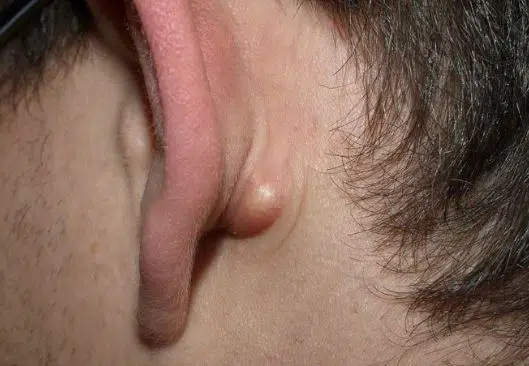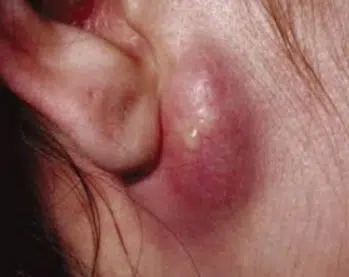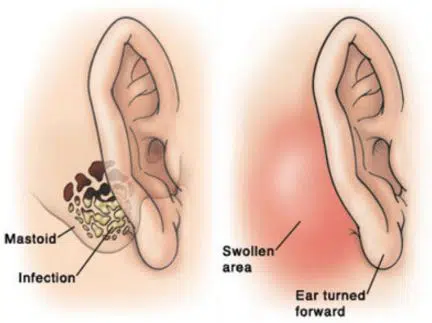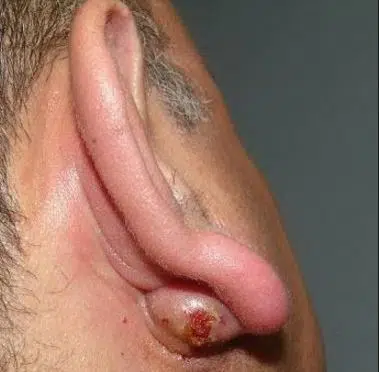A cyst behind the ear is just but a collection of all the dead skin cells, which are then observed as a lump behind the ear, or a bulged area. In most cases, earlobe lumps are sebaceous cysts behind the ear. Here are the causes, home remedies, and treatment options available to the people who have painful cysts behind the ear.
A cyst behind the ear and earlobes
You will normally find that the most common kinds of cysts found behind the ear or the earlobes are the sebaceous cysts. Often, this type of cyst come about because of the accumulation of dead skin cells or from the assembly of excess oil, which is normally secreted by the oil glands that are present on the skin surface.
In many cases, you will find that this kind of cyst is not dangerous, but there are cases where you may need to seek medical attention from your primary care physician. Cysts are said to have become dangerous the moment they start affecting major organs in the brain, or when they rupture, or start growing big.
It is important to note that a cyst has the potential to cause problems, even when it appears to be non-cancerous or benign. Apart from appearing behind your ear, they could also appear inside the ear, in the ear canal, as well as on your earlobe.
How to identify cyst behind the ear?
You can use a number of ways to identify the bump that has recently appeared behind your ear. The following are ways you can use in identifying the cyst that is behind your earlobe.
- Its growth is normally very slow
- In many cases, you will find that it is painless, however, if it were to become infected, you could experience pain, which would normally range between mild and severe.
- The cyst will normally disappear on its own without the need for you to intervene
- A cyst is generally a small lump made up of soft skin
- You could notice a whitish fluid oozing from that cyst, and in some cases, it may have some keratin in it. Keratin is a protein, which also happens to be a major component of the skin, hair, and nails, in the human body. If keratin is oozing from that cyst, then it is referred to as a keratin cyst, and it can make your earlobe to be very painful.
What you can and cannot do when you have a cyst
When you notice a cyst, there are a few things that you are advised to do, and there are other things that you should not attempt.
Do’s
- Remove all your earrings, more so, if that cyst is on the earlobe, and your earrings are surrounding or are close to that cyst. You need to remove them as the germs present on your jewelry could be transferred to that cyst, and this would end up making it even more painful.
- If you have long hair, make sure to wash it. Failure to wash your hair means that the oil present on it may find its way to the ears, and finally to the cyst, and this will translate to more problems for you. When you have this kind of yeast, it is recommended that you utilize anti-dandruff shampoo when washing your hair to make sure that all the pores are cleared.
Do Not’s
- Pop that cyst as it may end up aggravating it. This can also make it very painful
- Use any oily products, especially in the area behind your ear, or around the area that has been affected by that cyst
Causes of cysts behind the ear
You will find that there exist various reasons why a cyst could start developing in this particular area. Some causes are benign, but there are other serious causes. They include:
1. Acne
Pimples or lumps in your ear can develop whenever a pore or hair follicle gets clogged or blocked. The skin that is found behind your ears is not an exception. Even though pimples are less likely to develop here because this region is relatively isolated, there is always a possibility that this could happen.
2. Swollen lymph nodes
Lymphadenopathy is the medical term for swollen lymph nodes. It is a fancy way of saying that a person has a swollen lymph node. These types of cysts happen to be ovular, and vaguely shaped organs, which are distributed all over the human body. The nodes (lymph) are known to produce fluids in response to an infection that has taken place.
In the neck, there is a node, which can at times appear like a bump behind your earlobe in case it starts to swell. However, you should note that by itself, a lymph node should not be a source of concern as it is harmless, and comes about when the body responds to the different conditions, and can, therefore, be visible for a while.
3. Infection
Infections, which may cause throat swelling may also cause lumps and bumps to start appearing behind your ears. For instance, mononucleosis is a condition, which normally occurs alongside throat swelling. As such, the severity of this infection will normally determine the kind of concern that should be given to the lump that is behind the ear.
4. Lipoma
This is a fatty bump, which often forms between your skin layers. Normally, they can form on any part of your body and are in many cases quite harmless. In many cases, you may not notice the lipoma, but this will be dependent on its size and the number of layers that it has formed.
5. Abscess
Cysts and abscesses are very similar in that they are both capsules (enclosed) that are filled with fluids. However, you will find that abscessed are generally filled with pus, and they can develop around infections as well as foreign bodies.
6. Tumor
A tumor is a growth of tissue from your salivary glands, the skin behind the ear, or the mastoid bone. It comes about when cells begin to multiply uncontrollably rather than self-destruct when their life cycle comes to an end.
Fluid-filled cyst-like lump behind ear
Lumps appearing behind the ear are known as skin cysts. These are fluid-filled sacs, which form a raised, and dome-shaped region on the affected area of your skin. In some cases, you may find that they have a black spot at the top that is called a punctum.
You can easily move this type of cyst around as it is not fixed in a single spot. If you find that you cannot be able to move this cyst, it is recommended that you consult your physician.
Ganglion cyst behind the ear
Ganglion cysts are swellings or tumors found on a tendon covering or at the top of a joint. The cyst appears like a fluid-filled sac. Inside the sac, there is a thick, clear, sticky, colorless material, that also happens to be jelly-like. Cysts may feel and appear spongy, depending on their size.
- You may find that many small or a single large cyst has developed in this region. When there are many small cysts, they could give the appearance of more than a single cyst, yet they are connected by a single stalk deep within the tissues. You should not worry about this kind of cyst as it is not harmful. It also happens to account for close to half of all the soft tissues that are found in your hands.
- Also known as Bible cysts, the ganglion cysts tend to be more common among the women, with seventy percent of these cysts occurring in women who are between the ages of twenty and forty. In rare cases, they can occur in children who are below the age of ten years.
- These types of cysts mostly appear at the back of the hands, close to the wrist joint, though they could also appear on your palm, close to the wrist. For those that appear behind the wrist, they are more prominent when the affected person flexes his or her hand forward.
Symptoms of the ganglion cysts
The symptoms include:
- This kind of cyst normally appears in the form of a mass (bump), which often changes its size
- Ganglion cysts are soft, and it can range between one and three centimeters in diameter
- Swelling can appear suddenly or it could develop over time. Additionally, it may suddenly become small in size, or go away altogether, though it may appear again at a later time
- In many cases, the ganglion cysts have been known to cause a certain degree of pain. This often comes after sustaining repetitive or acute trauma. However, close to thirty-five percent of all cysts do not have symptoms, with the only indication of their presence being their appearance.
- If you notice the presence of pain, this means that this cyst is chronic, and it could be worsened by motions occurring in your joints.
- In the event that this cyst has been connected to a tendon, there is a high likelihood that you will feel some weakness in the finger that is affected.
Causes of ganglion cysts
The primary cause of the ganglion cysts is yet to be identified. However, there is a theory suggesting that trauma could be the reason why the joint tissues begin to break down. When these happen, small cysts are formed, which then join together to form a larger and more obvious mass.
Painful cyst on the bone behind the ear (mastoid bone)
Mastoiditis can be defined as a bacterial infection, which affects the mastoid bone. This bone normally sits behind your ear and is made up of several air spaces, which assists in draining your middle ear. Once the mastoid cells become inflamed or infected, normally due to an infection of the middle ear that has not yet been resolved, mastoiditis is likely to start developing.
When you have acute mastoiditis, there is a chance that this infection will start to spread to your mastoid bone, and this could cause very serious health complications for you. Typically, this condition affects children, though adults are also at risk. There are individuals who have chronic mastoiditis—an ongoing middle ear infection.
What causes mastoiditis?
As mentioned above, mastoiditis will normally start developing because of an infection present in the middle ear. The bacteria that is present in the middle ear will normally travel into these air cells that are present in the mastoid bone. Additionally, cholesteatoma, a skin cyst found in your middle ear could also block ear drainage, and this will, in turn, lead to mastoiditis.
Symptoms of mastoiditis
They include:
- Earlobe swelling
- Drainage from your middle ear
- Irritability, lethargy, and fever
- Tenderness and redness behind your ear
- Drooping and bulging of your ear (common in acute mastoiditis)
Pictures of a cyst behind the ear
Treatment for cyst behind the ear
There exist various treatments for cyst behind the ear. Your doctor will normally determine the cause before prescribing a treatment method. The most common treatment options include:
Antibiotics
A physician will normally prescribe antibiotics if the cause of the cyst is determined to be a bacterial infection. Often, bacterial infections are accompanied by cold, tonsillitis, flu, and mono. The antibiotics prescribed by the physician could be intravenous or oral. When you are prescribed antibiotics, you must make sure that you follow their full course to ensure that this problem will not recur in the future.
Topical corticosteroid creams
These types of creams come in handy in assisting relieve the symptoms associated with this condition such as itching and dermatitis. These are symptoms known to cause red bumps as well as skin rashes. In case itching does not cease, then you may be required to obtain oral antihistamines.
Surgery
your doctor may choose to perform a surgical incision to remove the growth that is behind the ear. Additional treatments include chemical treatment and chemotherapy.
Anti-acne medications
Even though acne has been known to heal on its own, there are medications that can assist in ensuring that you heal at a much faster pace. Antibacterial medications are often used in treating infected acne pimples. You may, however, be required to take anti-acne cures.
Home remedies for cyst behind the ear
When the cysts emerge behind your ear, they are normally very ugly, and to make matters worse, they could start draining a foul-smelling, cheesy like liquid. Rather than squeeze or pop the cyst, you should try the following home remedies. Squeezing or popping will not only be painful, but it could also increase your chances of getting an infection in the affected region. The best home remedies to consider include:
Tea tree oil
It is a beneficial home remedy as it contains vital antibacterial and anti-inflammatory properties. These particular properties are important in helping deal with conditions such as cold, toenail fungus, acne, headaches, as well as warts, not forgetting sebaceous cysts.
What to do at home
- Take some tea tree oil and proceed to dilute it
- Apply the diluted tea tree oil on the affected area
- Apply this solution three times each day
When diluting the tea tree oil, make sure you use water or a carrier oil. Proceed to dilute it in the ratio of 1:9
Aloe Vera
This is yet another essential home remedy that can be relied upon when dealing with cysts. Aloe Vera comes with healing and pain relieving properties, which you will need if the cyst has become infected.
What to do at home
- Extract the aloe gel from a fresh leaf
- Proceed to apply this gel on the affected ear region
Upon applying the aloe gel on the cyst, you can expect to experience a cool feeling in that area. If you would like to remove the impurities that may be present in your body, it is recommended that you drink aloe juice on a regular basis.
Castor oil
Castor oil has been known to produce effective results when used in treating cysts. The oil not only gets rid of any inflammation that could be present, but it also assists in relieving itching.
What to do at home
- Take a clean piece of cloth and soak it in castor oil
- Place the cloth on the cyst
- Obtain a hot water bag and ensure you place it directly on the cloth that is above your cyst
- Allow it to compress for at least thirty minutes before removing it
The heat provided by the water and the castor oil present in the cloth will speed up the healing process of your cyst. It works by shrinking the cyst.
Witch hazel
It is a home remedy known to contain astringent properties, which are vital in ensuring that the cyst heals at a fast pace. You will find that the leaves and the barks of the witch hazel contain tannins. The tannins come in handy in eliminating all the extra oils that could be clogging your pores.
What to do at home
- Pour a small amount of this home remedy in the area that has the cyst
- You can choose to use the witch hazel cream or gel
- Allow it enough time for it to properly soak into your skin
- Apply three times each day
The home remedies and treatment options discussed above will assist you in getting rid of the cyst that may be bothering you. If they do not work for you, or if the cyst recurs, you will need to see your physician for a detailed diagnosis.
References;
- https://treatcurefast.com/ear/lumps-behind-ear/lump-behind-ear-painful-hard-small-large-swollen-sore-soft-ear-lobe-lump/
- http://www.webmd.com/cold-and-flu/ear-infection/mastoiditis-symptoms-causes-treatments#1
- http://www.webmd.com/a-to-z-guides/ganglion_cyst#1
- http://www.doctorshealthpress.com/skin-care-articles/treating-lump-behind-ear
- https://homeremedyshop.com/17-home-remedies-for-sebaceous-cyst/



